We may earn commissions when you buy from links on our site. Why you can trust us.
7 Best Open-Ear Bluetooth Headphones
Open-ear Bluetooth headphones are a growing breed of discrete, safety-conscious sound purveyors that float a few millimeters off your ears and don’t cut you off from the outside world like conventional in-ear buds and big ‘ol headphone “cans” will do. So, there’s less chance of missing your train stop or ignoring the ominous honks of cars or make-way shouts of bike messengers. Despite their physical detachment from your ear canal, the best open-ear headphones can still deliver audio quality that can be surprisingly satisfying, as long as the environment around you isn’t too raucous.
Open-ear headphones are also easier on your ears. Their micro-drivers (speakers) don’t beat directly on your eardrums as sealed earbuds and headphones do, so they are not nearly as punishing. Maintain a moderate volume level, I’ve found, and you can keep listening for up to eight hours (until their rechargeable battery power runs out) without suffering the itchy ear syndrome and ringing that signal ear fatigue and can lead to permanent hearing damage.
When worn while driving or sitting at a desk, these microphone-equipped headphones let you safely and semi-privately take a hands-free call. The sound emanating from their wafer-thin acoustic packages is beamed towards your ears from just millimeters away, so the output only sounds like a whisper (if that) to others.
Which open-ear entertainers are the best? It depends on what factors – sound quality, design, ease-of-use, comfort, price – are more or less important to you. This priorities-focused guide of our picks for the best open-ear headphones will help you decide which open-ear headphones are right for you.
The best open-ear headphones for music: Bose Sport Open Earbuds
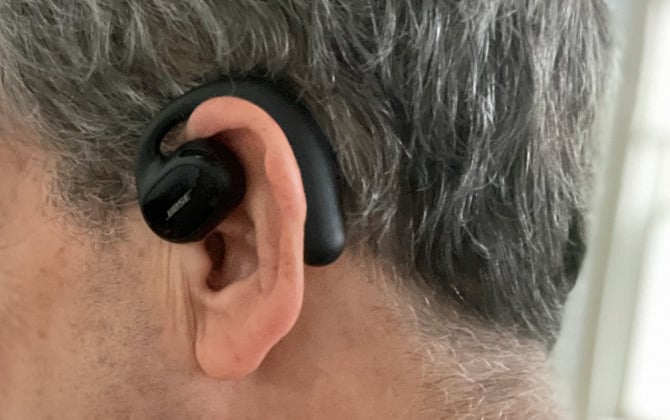
 No open-ear headphones sound better for music or phone calls than the uniquely styled, ear-wrapping Bose Sport Open Earbuds true wireless headphones. The precisely angled drivers hover just above and forward of the ear canals in small enclosures held securely in place with a rigid (but fairly comfortable) thermoplastic tube that curves around the back of the ear (and pushes your ear-flaps forward just a tad.) Tuned with Bose’s OpenAudio sound technology, the Sport Open buds boast excellent clarity, presence, and airy resonance, with bass response that’s only surpassed in this category by Bose’s second-generation Frames smart sunglasses.
No open-ear headphones sound better for music or phone calls than the uniquely styled, ear-wrapping Bose Sport Open Earbuds true wireless headphones. The precisely angled drivers hover just above and forward of the ear canals in small enclosures held securely in place with a rigid (but fairly comfortable) thermoplastic tube that curves around the back of the ear (and pushes your ear-flaps forward just a tad.) Tuned with Bose’s OpenAudio sound technology, the Sport Open buds boast excellent clarity, presence, and airy resonance, with bass response that’s only surpassed in this category by Bose’s second-generation Frames smart sunglasses.
Operating controls are also a notch above the rest in ease of use and reliability. There are tap/swipe volume adjusters and a multi-tasking button to take calls, pause/jog tracks, and summon voice assistance.
Minor caveats: The near-ear hovering of the Sport Open drivers does tend to obscure ambient sounds more than others do when music is cranked up. And while indoor phone calls sound terrific on both ends, outside noise/wind suppression is just so-so.
My only serious complaint is with standby battery life. Even when theoretically shut off, the Sport Open buds don’t hold onto a useable charge for more than two or three days. That compares with weeks or months of power-in-reserve for all others in our roundup. So while it is tempting to leave them in their extra-small and pocketable carry case, you’ll need to return the buds nightly to their custom charging base.
Sound Quality: A+
Playtime: 8 Hours
Charge time: 2 hours (full), 30 minutes (for 3 Hours)
Water resistance: IPX4 (splash resistant)
Weight: 13.89 grams/0.49 oz each
Charging connector: proprietary charging base
Price: $199
Buy Bose Sport Open Earbuds on Bose.com
Buy Bose Sport Open Earbuds on Amazon
The best open-ear headphones under $50: JLab JBuds Frames
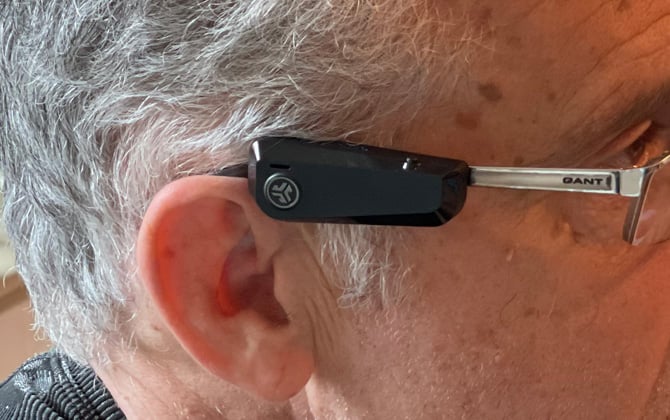
 Looking for an inexpensive and pragmatic way to try out open-ear listening? JLab’s first foray into off-ear headphones is just the ticket - a matched pair of two-inch-wide, open-ear speaker modules that clip onto the arms of most glasses or sunglasses. When positioned close to your ears, the sound quality of the 16 mm drivers is pleasing, with good clarity and more than a modicum of bass warmth that’s missing in some of the pricier open-ear Bluetooth headphones. Unfortunately, however, call quality is mediocre.
Looking for an inexpensive and pragmatic way to try out open-ear listening? JLab’s first foray into off-ear headphones is just the ticket - a matched pair of two-inch-wide, open-ear speaker modules that clip onto the arms of most glasses or sunglasses. When positioned close to your ears, the sound quality of the 16 mm drivers is pleasing, with good clarity and more than a modicum of bass warmth that’s missing in some of the pricier open-ear Bluetooth headphones. Unfortunately, however, call quality is mediocre.
Microphones are located in both left and right modules, control buttons too – so you can deploy just one (the right) if preferred for taking and making calls. You can use either JBud alone for music listening.
Granted, JBud Frames are kinda geeky looking, and you’ll need to take care when removing your newly audio-customized glasses, as these things can snag on hair/clothing/face mask ties and detach. But at $49, the JBuds’ price and performance are a winning combination.
Sound Quality: B
Playtime: 8 hours
Charge time: 2 Hours
Water resistance: IPX4 (splash resistant)
Weight: 11.7 grams/0.413 ounce each
Charging connector: Proprietary cable
Price: $49 on
The best open-ear headphones for sports: AfterShokz Aeropex
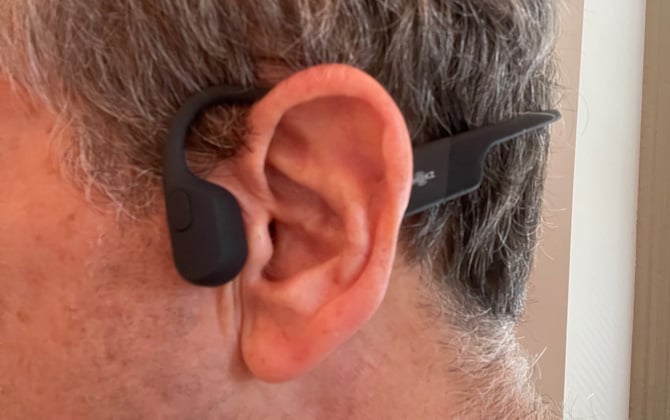
 Pioneers in open-ear headphones, AfterShokz uses bone conduction sound technology that transfers sonic vibrations to the inner ear through cheekbones instead of through your ear canals. (A variation is used in hearing aids for severe sufferers.) Earlier bone conduction models by the maker caused my face and teeth to vibrate. But the smaller, lighter, more flexible, titanium-banded Aeropex have made me a convert. I can easily shift their sealed transducers to rest in an off-the-ear spot that’s comfortable and produces shockingly sweet sound for music and calls. And with Aeropex’s effective, dual noise-canceling mic system, people on the other end of my calls haven’t suspected I’m not talking directly into my phone.
Pioneers in open-ear headphones, AfterShokz uses bone conduction sound technology that transfers sonic vibrations to the inner ear through cheekbones instead of through your ear canals. (A variation is used in hearing aids for severe sufferers.) Earlier bone conduction models by the maker caused my face and teeth to vibrate. But the smaller, lighter, more flexible, titanium-banded Aeropex have made me a convert. I can easily shift their sealed transducers to rest in an off-the-ear spot that’s comfortable and produces shockingly sweet sound for music and calls. And with Aeropex’s effective, dual noise-canceling mic system, people on the other end of my calls haven’t suspected I’m not talking directly into my phone.
The AfterShokz Aeropex are the open-ear headphones I’d most happily wear for a cycle or jog with their secure fore- and aft- head grip zones and the best-of-breed waterproofing – IP67 rated. Smaller heads should opt for the Aeropex Mini version fitted with a shorter wraparound headband. Both the Aeropex and Aeropex Mini pack compactly into a soft rubbery case that won’t bulge out your pants pocket too much, even when the charging cable is stowed inside.
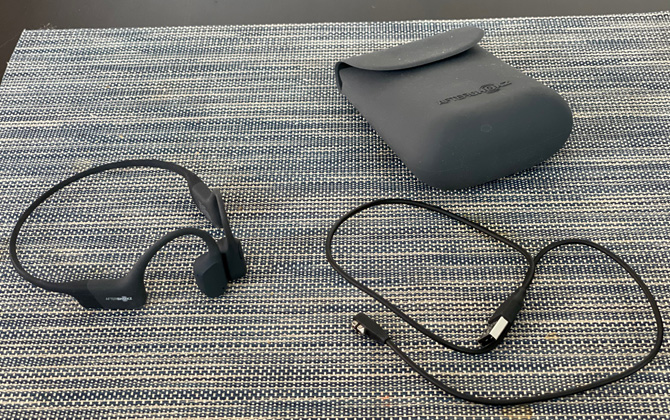
If the bone-conduction sound-transfer tech doesn’t bother you, these ultra-lightweight, marathon range entertainers are pretty terrific pals for active use.
Sound Quality: B
Playtime: 8 hours
Charge time: 2 hours
Water resistance: IP67 (waterproof, but not submergible)
Weight: 26 grams/0.92 oz
Charging connector: Proprietary cable
Price: $159.95 on
Buy AfterShokz Aeropex on AfterShokz
Buy AfterShokz Aeropex on Amazon
Best glasses-style open-ear headphones: Bose Frames
 Bose set the bar high with the first crop of audio-beaming Frames sunglasses and now have topped themselves with a second round. When I tested the first generation of Bose Frames audio sunglasses, I was surprised by how nicely they performed and looked. And they’re still a good value at $199. “You’d pay that much just for a pair of Ray-Bans [similar in looks] that don’t have audio built-in,” noted one gal-pal. But the Bose perfectionists have kept at the project. They now offer a second-gen of open-ear audio sunglasses, which raises the bar on multiple fronts – performance, features, and glossier aesthetics, making them the best audio glasses on the market.
Bose set the bar high with the first crop of audio-beaming Frames sunglasses and now have topped themselves with a second round. When I tested the first generation of Bose Frames audio sunglasses, I was surprised by how nicely they performed and looked. And they’re still a good value at $199. “You’d pay that much just for a pair of Ray-Bans [similar in looks] that don’t have audio built-in,” noted one gal-pal. But the Bose perfectionists have kept at the project. They now offer a second-gen of open-ear audio sunglasses, which raises the bar on multiple fronts – performance, features, and glossier aesthetics, making them the best audio glasses on the market.
The new Bose Frames have thermal touch controls to raise/lower volume. Polarized lenses are now standard, not an upgrade. And, by bulking out the arms a tad more, a beefier battery now powers these newbies for up to 5.5 hours on the rectangular-shaped Tenor and cat-eye-styled Soprano and up to 8 hours on the wraparound, sports-use focused Tempo model. That’s a significant improvement on the 3.5-hour run time available in the first-gen Alto and Rondo models. Maximum volume and bass response are likewise cranked up, especially in the Tempos that Bose says can be heard by a cyclist racing at up to 25 mph.
Like the first generation, Bose uses recessed micro-speakers firing down out of the bottom edge of the Frame arms, just above your ears. The sound is lush and artfully detailed, from tautly vibrating bass notes to shimmering cymbals and all stops in between. For calls and speaking with your voice assistant, two microphones (instead of one) in the new models do a better job at voice pickup.
I also should single out the Tempos for working with a standard USB-C charging cable – all other Bose audio headphones use a custom, magnetic 4-pin connector cable that costs $12 to replace. Bottom line - While the competition is growing, Bose models remain the open-ear audio sunglass standard-bearers.
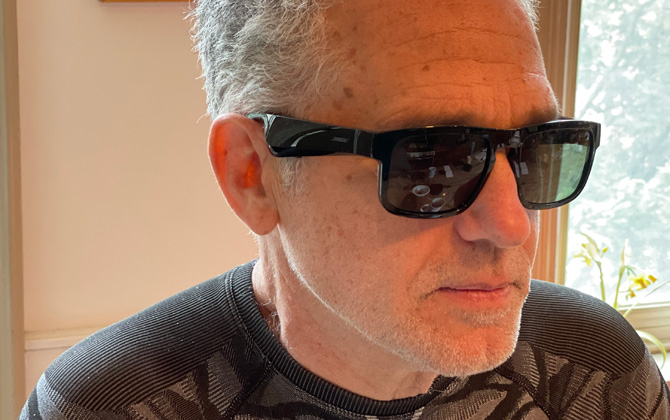
Bose Frames Tenor (shown above) and Soprano
Sound Quality: A
Playtime: 5.5 hours
Charge time: 1 hour
Water resistance: IPX4 (splash resistant)
Weight 49.9 grams/1.76 oz
Charging connector: Proprietary cable
Price: $249
Buy Bose Frames Tenor and Soprano on Bose
Buy Bose Frames Tenor and Soprano on Amazon
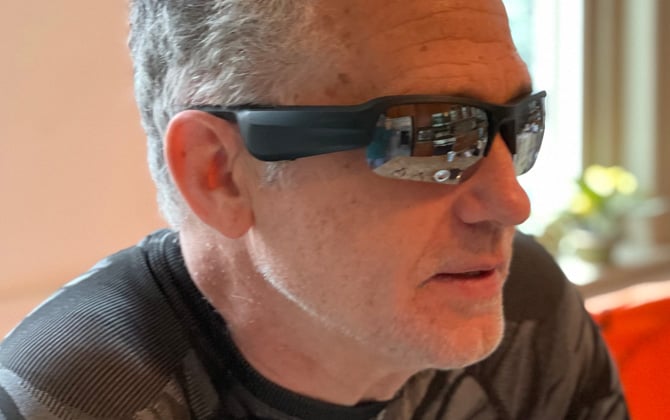
Bose Frames Tempo Sport
Sound Quality: A
Playtime: 8 hours
Charge Time: 1 hour
Water resistance: IPX4 (splash resistant)
Weight: 49.9 grams/1.76 oz
Charging connector: USB-C cable
Price: $249
Buy Bose Frames Tempo Sport on Bose
Buy Bose Frames Tempo Sport on Amazon
The Best open-ear headphones for maximum play time: Fauna Audio Bluetooth Glasses

 If you’re off on an extended trip into the wild, a pair of Fauna Audio Bluetooth Glasses can keep you entertained like no others. They’re the only open-ear audio sunglasses we’ve found with an onboard backup battery and recharging function packed into the hard-shell carry case (196 grams/6.91 ounces). So, after four hours of listening to music and making calls, you can return them to the case for a two-hour charge, and you’re good to go again – at least five times before the case itself needs recharging. I also like that the case connects for juicing up with a standard USB-C cable – most others in our report (except the Bose Frames Tempo) use a proprietary pin-ended charge cable that’s going to be a bother to replace if lost.
If you’re off on an extended trip into the wild, a pair of Fauna Audio Bluetooth Glasses can keep you entertained like no others. They’re the only open-ear audio sunglasses we’ve found with an onboard backup battery and recharging function packed into the hard-shell carry case (196 grams/6.91 ounces). So, after four hours of listening to music and making calls, you can return them to the case for a two-hour charge, and you’re good to go again – at least five times before the case itself needs recharging. I also like that the case connects for juicing up with a standard USB-C cable – most others in our report (except the Bose Frames Tempo) use a proprietary pin-ended charge cable that’s going to be a bother to replace if lost.
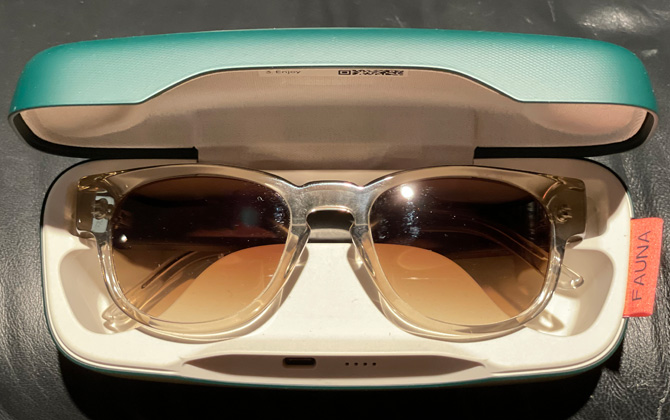
The Fauna Audio glasses are always ready to go, jump-starting their Bluetooth connection to your smartphone and triggering music to resume just as soon as you lift them out of their case. No button-pushing needed! With their solid Bluetooth 5.0 radio connection, I could venture to the other side of a sizeable pool and patio without losing a lock on my stationary music source (iPhone 12 Pro).
The Faunas are all fashion-forward, available in four different frame designs, with tinted or blue-light-blocking clear lenses. I opted for the Spiro Transparent brown acetate frame model with adjustable temple lengths and graduated amber-toned Carl Zeiss Vision sunglass lenses.
Faunas’ stereo sound is crystal clear through the onboard micro-speakers. Unfortunately, the two upward-firing woofers packed into the frames are a waste – shooting in the wrong direction and only noticeable if you cup hands over your ears. Phone calls played significantly lower than music and likewise required ear-cupping when trying to walk and talk on a noisy street.
The Faunas are among the most fashionable open-ear audio sunglasses and chock full of valuable features for a traveler if you’re not demanding A-grade primo sound.
Sound Quality: B
Playtime: 4 hours (up to 5x possible with battery case)
Charge time: 2 Hours
Water resistance: IP52 (rain-proof)
Weight: 50 grams/1.8 oz
Charging connector: Charging case with USB-C cable
Price: $249
Buy Fauna Audio Bluetooth Glasses on Amazon
Best prescription glasses-style open-ear headphones on a budget: Revel Tune

 If you’re looking for audio glasses with prescription lenses, Revel Tune from Glasses USA comes ready to wear out of the box. GlassesUSA does all the custom lens grinding, coating, and installation before shipping you the Revels, and with a 14-day money-back guarantee if you’re not satisfied. Offering discounted, direct-to-you pricing, a pair can be had for $168 including single vision (distance) or near vision (reading) prescription lenses, with all sorts of fine-tuning upgrades available, including blue light filtering and Transition lenses that magically self-adjust – to a degree – for both outdoor (tint) and indoor (clear) use.
If you’re looking for audio glasses with prescription lenses, Revel Tune from Glasses USA comes ready to wear out of the box. GlassesUSA does all the custom lens grinding, coating, and installation before shipping you the Revels, and with a 14-day money-back guarantee if you’re not satisfied. Offering discounted, direct-to-you pricing, a pair can be had for $168 including single vision (distance) or near vision (reading) prescription lenses, with all sorts of fine-tuning upgrades available, including blue light filtering and Transition lenses that magically self-adjust – to a degree – for both outdoor (tint) and indoor (clear) use.
I took compliments for the looks of the Revel Tune’s flat-black framed glasses and found them comfortable to wear and easy to operate. Music and calls crank louder than most, but in quiet zones, I couldn’t ignore the element of harmonic distortion that added a coarse thickening to vocals and acoustic instruments – piano, violin, acoustic guitars, flute, etc. True to their guarantee, the company sent a second replacement sample when I complained. But it, too, suffered the same. This sonic shortcoming might not bother a listener of already buzzy electronica, hip hop, and rock, but fans of acoustic jazz, folk, and classical should steer clear.
If you’re looking for attractive prescription glasses that have headphones built-in, the Revel Tune delivers excellent value.
Sound Quality: C-
Playtime: 3 hours
Charge time: 2 hours
Water resistance: IP54 (rain-proof)
Weight: 42.5 grams/ 1.499 oz
Charging connector: Proprietary cable
Price: starts at $168
Buy Revel Tune on GlassesUSA.com
Best glasses-style open-ear headphones under $100: Flows Bandwidth
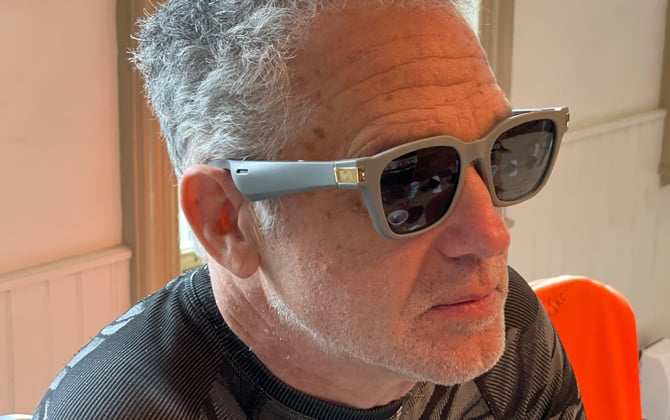
 The Flows Bandwidth provides a good value in audio glasses, with acceptable sound and two attractive styles – the more rectangular Bruno’s style (shown above) and the rounder front Taylor’s style. While it takes about 10 hours of break-in playtime, the Flows Bandwidth outputs considerable articulation and volume, spreading a wide and welcoming stereo sound field before your ears. Some unwanted edginess to vocals remains, though, and there’s hardly any bass to talk about.
The Flows Bandwidth provides a good value in audio glasses, with acceptable sound and two attractive styles – the more rectangular Bruno’s style (shown above) and the rounder front Taylor’s style. While it takes about 10 hours of break-in playtime, the Flows Bandwidth outputs considerable articulation and volume, spreading a wide and welcoming stereo sound field before your ears. Some unwanted edginess to vocals remains, though, and there’s hardly any bass to talk about.
If you need to wear a mask, the Flow’s wider body construction and deeper frame-to-face gaps have helped minimize lens fog-ups – a serious problem with all other, tighter-fitting audio eyewear, especially in cold weather.
Flows Bandwidth utilizes high-quality components (Qualcomm processor, Harman Kardon audio parts, seriously polarized polycarbonate lenses) and cuts costs on the extras. So, you get a flimsy cloth bag instead of a custom, hard-shell case that’s de-rigueur with other audio glasses makers. Flows Technology offers an optional, $7.95 neck strap and a lens pack (with swappable blue, gold, and blue light reflective sets) at $29.95.
Sound Quality: C
Playtime: 5 hours
Charge time: 1-2 Hours
Water resistance: IPX4 (splash resistant)
Weight: 50 grams/1.8 oz.
Charging connector: Proprietary cable
Price: $99.95
Buy Flows Bandwidth Bruno's and Taylor's style glasses on GetInFlows
[Image credit: Jonathan Takiff/Techlicious]
Jonathan Takiff has spent the last four decades career as staff music critic and tech columnist for the Philadelphia Daily News and Philadelphia Inquirer. His weekly “Gizmo Guy” column and monthly “New Releases” (album) column were syndicated nationally by the Knight-Ridder/Tribune Newswire. He also spent a decade hosting WMMR during its most adventurous “free form” era, breaking the likes of Bruce Springsteen, U2, Bob Marley, Weather Report, Carole King, Genesis, Pat Metheny, and Billy Joel. A period Jon chronicles in the liner notes for the “Legacy Edition” of Joel’s “Piano Man.” Jon has also contributed to Audio Video Interiors, Video, and Sound & Vision magazines.
Discussion 
I appreciate your post. Hollywood Marine Construction stands out through its unwavering commitment to the construction, maintenance, and revitalization of a wide range of waterfront structures, including boat docks, seawalls, piers, decks, patios, and gazebos. Our strong dedication revolves around delivering customized construction solutions that bring your project aspirations to life. Located strategically in Hollywood, Florida, our position at https://hollywood-docks.com/ provides convenient access to both Miami and Fort Lauderdale. We take immense pride in extending our services across a vast expanse of Southeastern Florida, serving communities like Pembroke Pines, Miramar, Fort Lauderdale, Hialeah, Pompano Beach, and Miami.

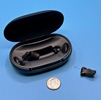

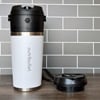

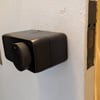








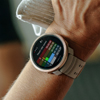
From Barbara on July 19, 2021 :: 6:40 pm
I love my AfterShokx bone conductions headphones - I’ve used them for two years. My only complaint is the loop over the ear is not adjustable and the backs of my ears get sore after several hours wearing them. The sound is very good but I like being able to hear what’s going on around me, too.
Reply